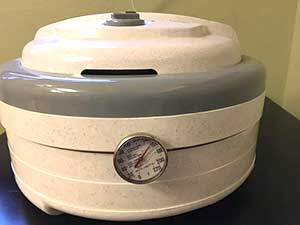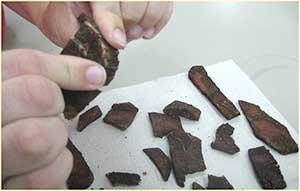Jerky is an easy to make flavorful snack. Remember when processing any meat, food safety must be at the forefront. In recent years, illnesses due to Salmonella and E.coli O157:H7 from homemade jerky have raised questions about the safety of traditional drying methods.
Preserving jerky 5-minutes presentation
Safe drying temperature and time
It is important that the meat strips reach a sufficient temperature in the drying process to kill harmful pathogens that may cause foodborne illness. Dry in a food dehydrator, or oven, maintaining a temperature of at least 145 to 155 F for 6 hours. To ensure the meat strips reach a temperature where pathogens are destroyed, the University of Wisconsin recommends heating the jerky (after drying) in a preheated 275 F oven for 10 minutes. This method, as a final step in the drying process, achieves an extra margin of safety and produces a quality jerky product
After drying, heat the jerky in a preheating 275 oven for 10 minutes to ensure a safe product.
Check temperature with food thermometer
Take time to check the temperature of your dehydrator before drying. Place the metal stem of a dial thermometer between two trays so you can read the dial outside the dehydrator. Turn on the dehydrator and allow the temperature to stabilize. Adjust the thermostat to reach current research temperature recommendations of 145 F or above.
Use high-quality meat
For quality jerky, use only lean meats in excellent condition and trim visible fat.
Freeze meat first
Freezing the venison prior to marinating makes it easier to slice and helps kill any parasites that might be present. Always marinate meat strips in the refrigerator, not on the counter. Dehydrate until a test piece cracks but does not break when it is bent.
Jerky can be stored for 1 to 2 months at room temperature and in the freezer for up to 6 months.
- North Dakota State University. Jerky Making: then and now.
- New tips for safely preparing jerky at home. 2010. University of Wisconsin.
Reviewed in 2021




